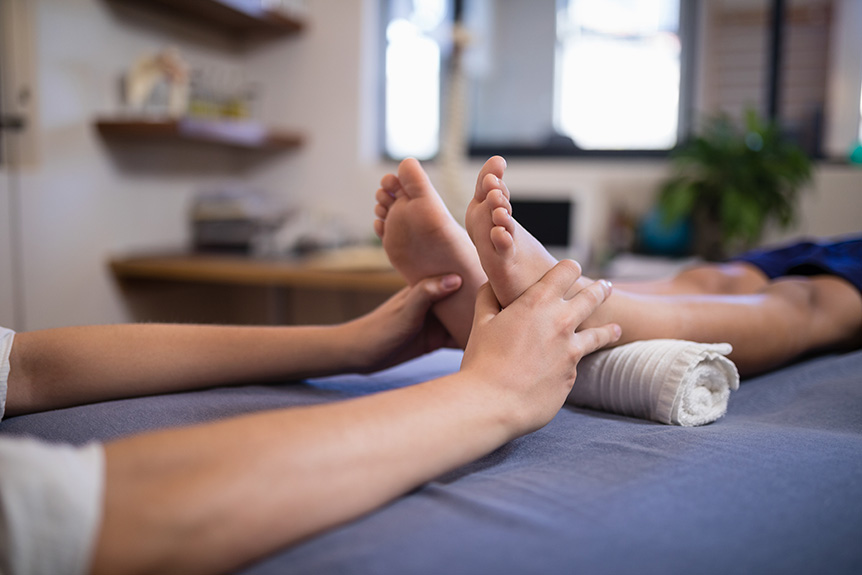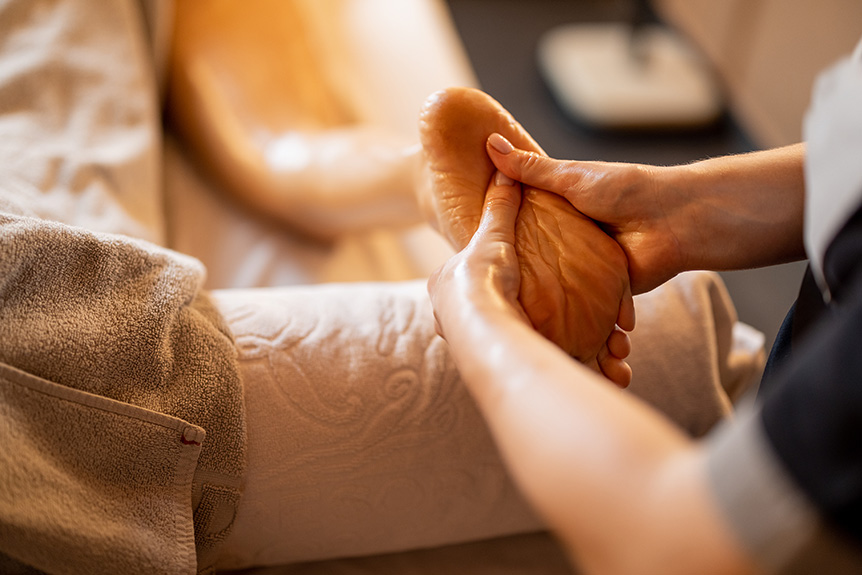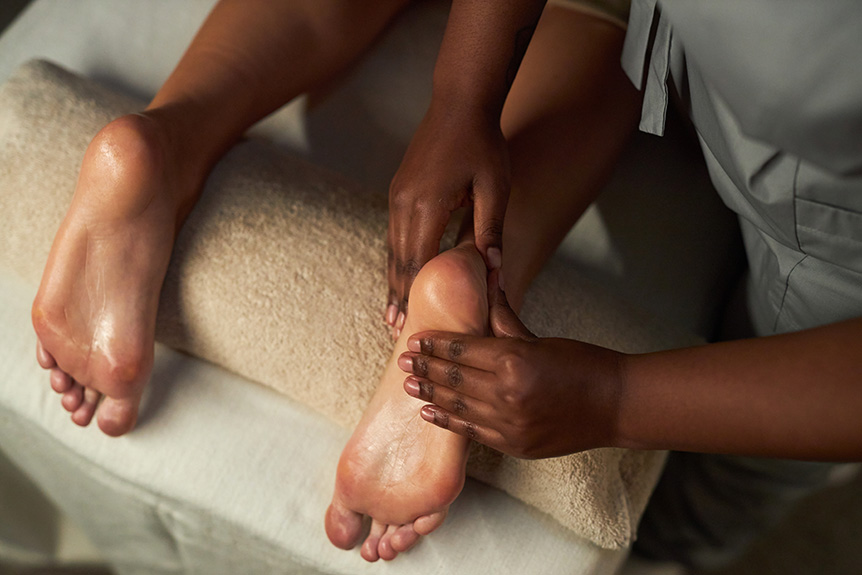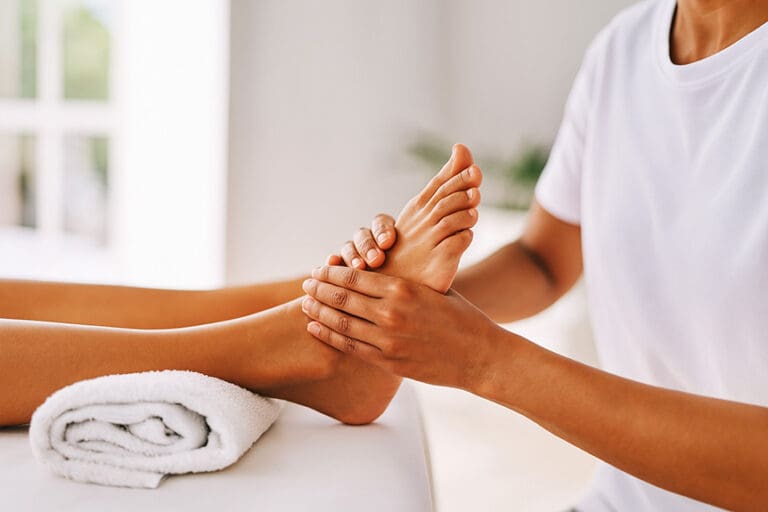It can help reduce foot pain by applying graded, precise pressure to plantar, dorsal, and lateral zones innervated by tibial and peroneal nerves. This stimulates mechanoreceptors, engages spinal gate-control mechanisms, modulates autonomic tone, and may ease nociceptive signaling. It does not treat underlying pathology but complements load management, footwear optimization, and medical care for conditions like plantar fasciitis, tendinopathy, or neuropathic discomfort. Benefits include decreased perceived pain, reduced guarding, and improved comfort over multiple sessions. Further details clarify mechanisms, expectations, and safe use.
What Is It and How Does It Work for Foot Pain?

How does it modulate foot pain? It is a structured manual therapy applying graded pressure to defined plantar, dorsal, and lateral foot zones innervated by tibial and peroneal nerve branches.
Mechanistically, it likely engages segmental inhibition within the spinal cord, activates descending pain‑modulatory pathways, and stimulates mechanoreceptors that compete with nociceptive input (gate control).
Evidence suggests autonomic rebalancing—lowered sympathetic tone and improved microcirculation—may ease ischemic sensitivity in soft tissues.
At Spa & Massage in London, therapists use calibrated thumb‑walking and sustained holds over metatarsal heads, medial arch, and heel pad, respecting fascial lines and joint biomechanics.
Sessions are adapted to tenderness mapping and client feedback.
Post‑session, our therapists recommend gentle calf–plantar stretching and hydration to support tissue perfusion and prolong analgesic effects.
Many people also turn to reflexology because of its healing power, believing it provides holistic support for overall well-being beyond just pain relief.
Common Causes of Foot Pain and When This Therapy May Help
Foot pain commonly arises from mechanical overload of the plantar fascia, intrinsic foot muscles, and Achilles–calcaneal complex, as well as inflammatory conditions and peripheral neuropathic processes.
It may help reduce nociceptive signaling and perceived muscle tension associated with overuse and mild inflammatory irritation, complementing rest, load management, and footwear modification recommended by Spa & Massage therapists.
When symptoms suggest neuropathy (burning, numbness, allodynia) or persistent inflammation with swelling and warmth, it is adjunctive only, and clients should be triaged for medical assessment while receiving gentle, non-provocative techniques.
Overuse and Strain
Why does overuse so often precipitate foot pain? Repetition loads the plantar fascia, intrinsic foot muscles, Achilles tendon, and metatarsal heads beyond their tissue capacity, producing microtrauma faster than collagen can remodel. Prolonged standing, abrupt mileage increases, unsupportive footwear, and hard surfaces amplify tensile and compressive stress, leading to myofascial trigger points, tenosynovial irritation, and periosteal tenderness.
Clinically, patients report morning stiffness, focal plantar soreness, forefoot ache with push-off, or calf tightness that tethers the heel.
Within Spa & Massage clinics, this may assist as an adjunct by modulating pain via pressure-mediated mechanoreceptor input, enhancing local circulation, and downregulating muscle guarding. Therapists apply graded, precise thumb-walk techniques along plantar arches and metatarsal grooves, paired with calf release. Clients are guided on load management, footwear fit, cadence changes, and gentle foot-intrinsic strengthening between sessions.
Inflammation and Neuropathy
Often overlooked, inflammatory disorders and peripheral neuropathies are major drivers of foot pain, presenting with distinct yet sometimes overlapping patterns. Inflammation from plantar fasciitis, rheumatoid arthritis, gout, or tendinopathy typically produces localized tenderness, warmth, and morning stiffness along the plantar fascia, metatarsophalangeal joints, or Achilles insertion.
Neuropathy—common in diabetes, B12 deficiency, entrapment (tarsal tunnel), or chemotherapy—presents with burning, tingling, numbness, and nocturnal hypersensitivity, often in a stocking distribution.
From Spa & Massage’s perspective, zone therapy does not treat the underlying pathology, but gentle, targeted pressure can modulate autonomic tone, improve perceived circulation, and reduce pain signaling. Therapists prioritise non-irritating pressure, avoiding inflamed foci, and coordinate with medical care.
Red flags—rapid swelling, infection signs, sudden neurological loss, or ulceration—warrant urgent evaluation. Regular sessions complement graded loading, footwear optimisation, and glycaemic control.
Evidence and Benefits: What Clients Can Expect From Sessions
Across clinical literature, it shows modest but meaningful effects for nonspecific foot pain, stress-related tension, and perceived wellbeing, primarily via nociceptive modulation, autonomic balancing, and improved microcirculation.
Clients can expect focused pressure to plantar fascia, intermetatarsal spaces, and reflex zones along the medial and lateral longitudinal arches. Typical sessions reduce perceived pain intensity, ease muscle guarding, and downshift sympathetic arousal, often reflected in slower heart rate and deeper breathing.
Light edema may soften as capillary perfusion improves. Benefits commonly unfold over 3–6 sessions, with incremental gains in sleep quality and gait comfort.
At Spa & Massage in London, sessions are delivered with measured pressure, paced exhalation cues, and unscented or hypoallergenic oils when needed, followed by simple home care: gentle calf stretches, hydration, and heat as tolerated.
How Our Therapists Tailor This Therapy at Spa & Massage

At Spa & Massage, each massage session begins with a brief, structured consultation to map pain location, activity load, and contraindications.
Therapists then prioritise specific plantar reflex zones linked to the heel fat pad, plantar fascia, tibial nerve distribution, and metatarsophalangeal joints, guided by symptom provocation and palpatory findings.
Pressure and pacing are calibrated in real time—modulating Newtons of force, contact surface, and stroke cadence—to optimise analgesia while avoiding tissue irritability.
Personalised Consultation
Why do precise intake details matter before pressure point therapy for foot pain? Because differential diagnosis of foot pain is multifactorial.
At Spa & Massage, therapists begin with a structured consultation: pain onset, aggravating/relieving factors, footwear habits, training load, sleep quality, and stress. They document location patterns—plantar fascia origin, heel pad, first MTP joint, midfoot, lateral column—and characterize pain (nociceptive vs neuropathic descriptors, morning start-up stiffness, night pain).
Medical history screens for diabetes, peripheral neuropathy, anticoagulants, pregnancy, recent injury, and infections.
Objective checks include observable edema, erythema, temperature asymmetry, tissue turgor, and range of motion in the ankle and subtalar joints.
These details inform session goals, pressure tolerance, and positioning, and guarantee appropriate precautions.
Clients feel seen; therapists work safely, intentionally, and intimately aligned to the body’s signals.
Targeted Reflex Points
Building on the intake findings, Spa & Massage therapists map symptoms to specific reflex zones to modulate nociceptive input and support local tissue recovery.
For metatarsalgia, they prioritise the transverse arch reflex and adjacent intermetatarsal grooves.
For plantar heel pain, they address the medial calcaneal margin and proximal plantar fascia reflex lines.
Hallux-related strain directs attention to the great toe’s distal phalanx reflex, including flexor hallucis longus insertion points.
They also engage ankle, lumbar–sacral, and knee reflex zones when gait mechanics or referred pain patterns are suspected.
Palpation identifies taut, granular, or hypersensitive nodules that may correlate with overuse or microinflammation.
Within sessions at London clinics, targeted work is combined with gentle lymphatic reflex lines to reduce oedema, enhance perfusion, and invite steadier comfort.
Pressure and Pacing Adjustments
Two variables govern therapeutic effect in zone therapy for foot pain: load (pressure) and tempo (pacing).
At Spa & Massage, therapists modulate both based on tissue response, pain thresholds, and goals. Firm, sustained pressure over the plantar fascia, intrinsic foot muscles, and metatarsal heads recruits mechanoreceptors, inhibits nociception, and improves local circulation.
Lighter, rhythmic pacing calms autonomic arousal and eases guarding around the tibial nerve and calcaneal attachments.
Assessment begins with palpation to map tenderness, edema, and fascial drag. Pressure is increased gradually to the client’s “therapeutic edge,” never forcing through sharp pain.
Pacing alternates between slow holds for adhesions and gentle cycles to downregulate tone. Therapists document responses and adjust across sessions, ensuring relief feels precise, respectful, and consistently reproducible.
Self-Care Tips and Aftercare to Enhance Results
An effective aftercare plan following it targets tissue perfusion, neuromuscular relaxation, and load management to prolong analgesic effects. Immediately post-session, gentle ankle pumps, toe flexion–extension, and slow diaphragmatic breathing sustain circulatory and parasympathetic shifts.
Hydration supports microvascular clearance; our therapists recommend warm water sipped steadily over several hours.
For plantar tissues, a 2–3 minute self-mobilisation with a smooth ball under the medial arch modulates fascia without provoking irritation.
At Spa & Massage, therapists often apply a light, hypoallergenic oil blend; at home, clients can repeat a feather-light effleurage from heel to forefoot to quiet overactive intrinsic muscles.
For load management, alternate supportive footwear with cushioned insoles and limit high-impact bouts for 24 hours.
Brief contrast hydrotherapy calms edema and preserves comfort.
When to Seek Medical Advice and How to Combine Treatments

While this therapy can modulate nociception and autonomic tone, certain presentations warrant medical assessment before or alongside therapy. Red flags include acute, non-weight-bearing pain; progressive neurologic deficits (numbness, weakness); calf swelling with warmth (DVT risk); fever or spreading erythema (infection); open wounds, diabetic ulceration, severe deformity, trauma, or new vascular symptoms (pallor, coldness).
Persistent morning heel pain, refractory forefoot pain, or pain disrupting sleep also merits clinical evaluation.
Combining care is often ideal. At Spa & Massage, therapists collaborate with clients’ GPs, physiotherapists, and podiatrists. It may be integrated with deep tissue or sports massage for myofascial load, gentle joint mobilisations, footwear modification advice, and graded activity.
For inflammatory flares, medical guidance on NSAIDs or orthoses is appropriate. Therapists document symptom patterns, adjust pressure dosing, and pause treatment when red flags emerge.
Conclusion
In the end, pressure point therapy for foot pain resembles a measured return to Ithaca—structured, patient, and guided by maps of anatomy rather than myth. By modulating pressure on plantar, medial, and lateral foot zones, it may ease myofascial tension, enhance microcirculation, and downshift sympathetic tone. While evidence remains mixed, clients often report reduced heel and arch discomfort when sessions complement targeted massage, loading modifications, and footwear changes. Persistent neuropathic signs, acute trauma, or inflammatory red flags warrant medical assessment and integrated care.



